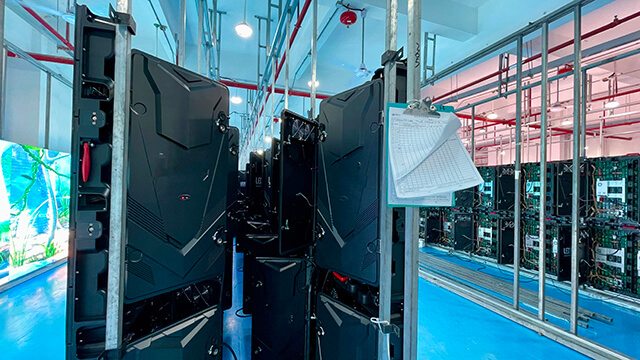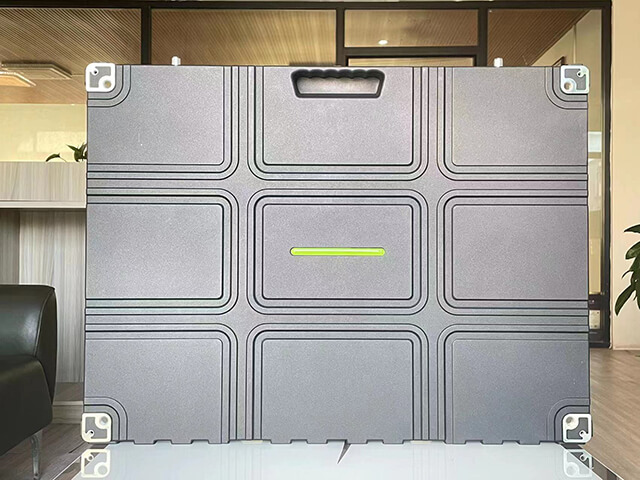- Home
- Product
- Hot
- About Us
- Service
- Solutions
- News
- Contact Us
- All
- Product Name
- Product Keyword
- Product Model
- Product Summary
- Product Description
- Multi Field Search
Views: 0 Author: Site Editor Publish Time: 2023-08-01 Origin: Site








What is led screen cabinets?
Led cabinets, or LED screen frames, are the modular units on which a LED screen is assembled. Most LED screens are large or even gigantic, so it stands to reason that the most convenient method to assemble them is to divide the screen into smaller cabinets. When these cabinets are combined, we get the full surface of the screen. These cabinets vary in size, building materials and customization depending on the type of LED screen that you want to assemble.
The main function of the LED screen cabinet is to provide a structure to support and protect the LED module, and to provide an interface for power supply and signal transmission. The design of the LED screen cabinet usually takes into account factors such as heat dissipation, dust resistance, water resistance and earthquake resistance to ensure the normal operation and long life of the LED display.

What are the types of LED display cabinets?
LED display cabinets are screen frames. They are modular units on which we assemble the display screen. These display cabinets can vary in:
Size
Manufacturing material
Specifications depend on the type of display screen.
1.Classification of LED display cabinets based on size
There are different LED display sizes. Here are some common standard ones:
For outdoor fixed projects: 960×960 mm, 1024×1024 mm, 768×768 mm.
For indoor fixed projects: 640×480 mm, 640×640 mm, 960×480 mm.
For rental event projects: 500×500 mm, 500×1000 mm, 512×512 mm, 576×576 mm, 640×640 mm.



2.Classification of LED display cabinets based on manufacturing material
We can classify LED screen cabinets based on the material used in manufacturing. On this basis following are the types of LED screen cabinets:
Galvanized iron material
High-end die-casting aluminum alloy
Magnesium alloy
Let us briefly discuss each type of cabinet.
(1) Galvanized iron LED display cabinet:
It is one of the most common LED display cabinets. It has extensive use in outdoor LED screens. If we talk about its advantage, we must consider its good sealing ability. Moreover, it also offers affordable prices.
Every device, along with its advantages, also have some disadvantage. And these disadvantages include heavy weight and low accuracy compared to die-casting cabinets. We usually use these for large outdoor screens and billboards. It weighs about 38 kg/m2 for an outdoor iron cabinet.

(2) Die-cast aluminum alloy:
We have already discussed the disadvantages of the iron cabinet. Unfortunately, these drawbacks do not support screens with small spacing needs.
So, the new materials grab the attention of the market. Among the latest materials, the die-cast is the most popular one.
After working on this material for years, we can now introduce lighter cabinets in the market.
It offers a range of advantages. These include lightweight, more reasonable, and high accuracy. Besides, it can realize seamless splicing.
The latest die-cast aluminum display screen has comprehensive optimization. It is one of the newest versions of the traditional display box. Rationalization occurs in both structure and performance.
It is actually for rental display screens. Besides, it is for fine pitch LED display. We make it with a patent and high-precision box. It has convenient disassembly and assembly. It has incredibly convenient maintenance. Moreover, there is a list of its advantages which includes:
There is no seam between the cabinets.
It effectively controls the tolerance range.
It adopts a hoisting structure.
It adopts a power and signal connector for easy connection.
Connection is safer and reliable.


3. Magnesium alloy LED display cabinet:
Magnesium alloys consist of magnesium and other elements. These cabinets are essential as they offer a wide range of advantages. Their characteristic features are as follows:
It has a low density (about 1.8g/cm3 magnesium alloy)
It has a high specific strength.
Its elastic modulus is large.
It has good heat dissipation without air-conditioning.
It has good shock absorption.
It has a more extraordinary ability to withstand impact loads than aluminum alloys.
It has good resistance to organics and alkalis.
These displays have high-cost performance. They tend to save costs on steel structures and air conditioning.
They are easy to install
They tend to have zero noise.
All these features make it more workable hence increasing its demand. Moreover, they enhance the lifespan of the display.

4. Classification of LED display cabinets based on environment
Now we will discuss the classification of LED cabinets based on environment. In this part of the classification, we have three types. These types include:
Fixed cabinets for outdoor installation
Fixed cabinets for indoor installation
Cabinets for external facades
Let us briefly describe each type of cabinet one by one.
(1) Fixed LED display cabinets for outdoor installation:
For the outdoor LED screen, we need weather-resistant cabinets. They must tend to withstand all weather conditions. The material and design must be ready for any situation.
We have a variety of designs to install in an outdoor setup. But for me, the best investment in such cases is double back door designs. They are better than the standard type of single back door types. Moreover, they have a simple assembly.
But like other cases, it also offers a disadvantage. Weather-resistant materials are heavier in weight. So, we are going to face the burden of weight. Besides, the average weight for these units sits around 35~50 kg/m2.

(2) Fixed LED display cabinets for indoor installation:
We use these types of cabinets in indoor LEDs. We do not have to worry about weather changes because these are indoor use. The material used does not need many weather-resistant qualities. Like its walls can be thinner and can have openings. On average, the weight of these units is around 20-30 kg/m2.
They also offer low cost. Its lower price makes it the ideal cabinet for indoor LED screens in stores and shops.

(3) LED display cabinets for external facades:
This type of cabinet is for outdoor screens placed on walls or facades. Its design makes it easier to assemble on the wall.


5. Other commonly used LED display cabinets:
(1) Sealed LED display cabinet:
We can divide these cabinets based on the use of display screens. For example, they can be indoor and outdoor sealed cabinets.


(2) Indoor sealed cabinet:
As the name indicates, we use this cabinet for indoor screens. They come with a back cover. We do not commonly use this cabinet now due to two reasons:
Due to its maintenance method
Due to its high cost

(3) Front open LED display cabinet:
We also install LED displays on the walls. In the case of such installations, there is no space on the back side of the display screens. Front open cabinets are suitable for this kind of installation. It is also best for double-sided screens with no space between the sides.


(4) Curved/Circular/Right angle LED cabinet
Iron steel cabinet is specially designed for various curved screens. The classification of curved cabinet: divided into external curved, internal curved two kinds. And all kinds of special shaped curved screen need steel/iron cabinet.






(5) Dual-face LED display cabinet
Double-sided LED display also known as LED dual service cabinet, it`s mainly used in electronic displays that need to be displayed on both sides, such as the pole street LED display cabinet.
The cabinet structure of the display screen on both sides is equivalent to two front maintenance screens connected back-to-back. The double-sided cabinet is also a special forward structure cabinet. The middle belongs to a fixed structure, and the two sides are connected with the upper part of the middle.




(5) Perimeter sports LED display cabinet


(6) Cross LED display cabinet

What are main characteristics of led screen cabinets?
(1) Modular design:
The LED screen cabinet is composed of multiple modules, which can be flexibly assembled and disassembled. This makes the installation, maintenance and upgrade of the LED display more convenient.
(2) Light and strong:
LED display cabinets are usually made of lightweight metal or plastic materials, with a strong structure and low weight. This helps reduce installation costs and improve mobility.
(3) Heat dissipation design:
LED screen cabinets usually have heat dissipation devices such as radiators or fans to effectively dissipate heat and maintain the normal working temperature of the LED module. This helps to improve the stability and life of the LED display.
(4) Interface and connection:
The LED screen cabinet provides a power interface, signal input interface and data transmission interface and other connection points for connecting LED modules, power supplies, control cards and other components.
(5) Protection and waterproof performance:
LED display cabinets are usually protected and waterproof designed to protect the LED module from the external environment. This includes sealing joints, waterproof coatings, and dustproof designs.
(6) Maintenance and repair:
The design of the LED screen cabinet should take into account the convenience of maintenance and repair. For example, detachable panels, easily replaceable components, and easily accessible interior Spaces can reduce the difficulty and cost of maintenance work. Free send you repair led display professional guide.
(7)The type and specifications of LED display cabinets vary by vendor and application.
LED displays with different sizes, pixel densities and installation requirements usually use LED display cabinets of different designs.
What are the maintenance methods of LED screen cabinets?
LED screen cabinets are engineered to make things simple, so it is easier to run the maintenance of the internal components.There are two maintenance methods for the LED display: front and rear maintenance.
As the name implies, the front maintenance is the maintenance and overhaul from the front of the cabinet.
And the rear maintenance is the maintenance and overhaul from the back of the cabinet. These two maintenance methods can exist in a LED cabinet. It is called dual maintenance.
(1). Front maintenance
The magnetic element and the LED screen cabinet are fixed by magnetic adsorption. When disassembling, use the suction cup tool to remove the led module directly from the front of the box to realize the front maintenance of the screen.
With the rise of small-pitch LEDs, front-maintenance indoor LED display products have gradually dominated the market. This front maintenance method can make the screen structure lighter and thinner, blending with the surrounding environment, and highlighting the visual expression effect.




(2). Rear maintenance
Large-scale LED display screens used for building exterior walls adopt rear maintenance and must be designed with maintenance channels.
The purpose is to facilitate maintenance personnel to perform maintenance and repairs from the back of the screen. Installation and disassembly are cumbersome, time-consuming, and laborious.
The rear maintenance method is suitable for installation scenarios such as roof type and column installation, and the maintenance efficiency is high. Customers can choose maintenance methods according to actual needs.
